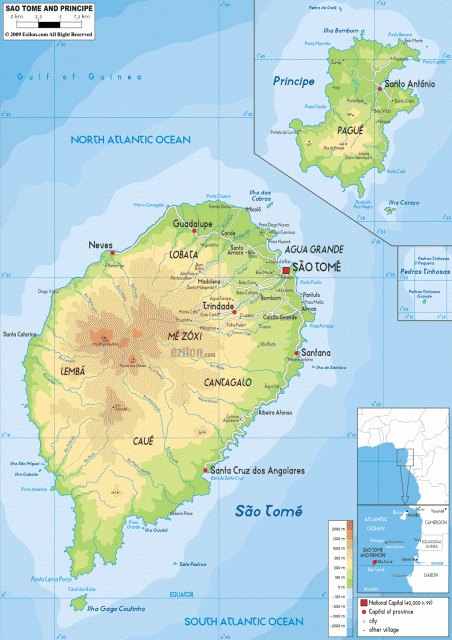Democratic Republic of Sao Tome and Principe
POPULATION: 186,300 (2014)
AREA: 372 sq. mi. (964 sq. km)
LANGUAGES: Portuguese (official); Fang, Kriolu
NATIONAL CURRENCY: Dobra
PRINCIPAL RELIGIONS: Roman Catholic (89.5%), Evangelical Protestant, Seventh-Day Adventist
CITIES: Sao Tome (capital), 43,000 (1993 est.); Trindade, Santana, Neves, Porto Alegre, Santo Antonio
ANNUAL RAINFALL: Varies from 40 in. (1,000 mm) in northern lowlands to 150–200 in. (3,800–5,000 mm) in highlands.
ECONOMY: GDP $337.4 million (2014)
PRINCIPAL PRODUCTS AND EXPORTS:
- Agricultural: cacao (cocoa), coconuts, coffee, bananas, palm kernels, cinnamon, poultry, pepper, papayas, beans
- Manufacturing: textiles, soap, beer, fish processing, timber
GOVERNMENT: Independence from Portugal, 1975. Republic with president elected by universal suffrage. Governing body: Assembleia Nacional, elected by popular vote.
HEADS OF STATE SINCE INDEPENDENCE:
- 1975–1991 President Manuel Pinto da Costa
- 1991– President Miguel Trovoada
ARMED FORCES: 800 (1997 est.)
EDUCATION: Compulsory for ages 7–14; literacy rate 73% (1991 est.)

Sao Tome and Principe, which consists of two islands in the Gulf of Guinea, is one of the smallest countries in Africa. However, its strategic location off the coast of West Africa has given it an importance out of proportion to its size and population.
The two islands, Sao Tome and Principe, are part of a chain of volcanoes that stretch to CAMEROON. Because of this, their terrain is very rugged. The climate of Sao Tome, the larger island, varies by altitude. The mountainous interior receives heavy rainfall almost year round, but the climate is drier below about 3,000 feet. The nation's capital, Sao Tome, sits on a plain near the coast. The smaller island, Principe, lies northeast of Sao Tome island.
History and Government
Portuguese sailors discovered the uninhabited islands of Sao Tome and Principe around 1472. Using slaves from mainland Africa as laborers, the Portuguese established sugar plantations on the islands. These served as models for the sugar plantations in the Americas. Over time, a variety of other immigrants reached the islands. The mix of European and African influences produced a unique CREOLE culture that still exists.
In the 1600s the sugar market declined, and Sao Tome and Principe became a supply station for slave ships sailing between Africa and the Americas. In the late 1800s the plantations made a comeback with the introduction of coffee and cocoa. The society became strictly divided into groups of free white planters, mixed-race planters known as forros and filhos da terra, and plantation workers called servicais and tongas. Forced to work on the plantations, the laborers had no political rights.
In 1975 Sao Tome and Principe gained its independence from Portugal. Manuel Pinto da Costa served as the nation's first president from 1975 to 1991. Under his rule the islands became a socialist state with all businesses under state control. By 1985 the economy was in steep decline. Two years later da Costa agreed to reduce the state's role in the economy in return for aid from the World Bank and the International Monetary Fund.
The results of the economic reforms have been disappointing. The value of the currency has plummeted and prices have shot up, causing occasional food riots. The instability of the government has made these problems worse. Political offices change hands frequently, but they are generally filled only by individuals from the forro class. In 1991 Miguel Trovoada, a former colleague of da Costa, was elected president. He faces strong opposition in the legislature (Assembleia Nacional), which has hindered his ability to make changes.
Economy and Peoples
Cocoa dominates the economy of Sao Tome and Principe. About 60 percent of the arable land is devoted to cocoa production, which accounts for nearly all of the country's export revenue. Most of the cocoa is grown on large plantations established during the colonial era. However, such heavy dependence on cocoa has caused severe economic problems in years when the price of cocoa fell. Sao Tome and Principe has also long served as a distribution center for goods moving between Africa and the rest of the world because of its location off the coast of West Africa.
The leaders of Sao Tome and Principe have been investigating ways to expand the economy by developing new industries. They have recently discovered promising oil reserves beneath the islands, but have not yet begun to exploit them. Tourism is another possibility. The islands' favorable climate and natural beauty make them an ideal tourist spot. Although a luxury resort recently opened on Principe, development of a tourist industry has been hindered by poor infrastructure, limited overseas transport links, and a lack of trained personnel.
The class structure established in the colonial era still exists to some extent in Sao Tome and Principe, with the oldest forro families controlling the best land. These families also hold considerable power in important local associations. While the different groups no longer live in strict separation, class still plays an important role in defining social relations on the islands. (See also Class Structure and Caste, Colonialism in Africa, Plantation Systems, Tourism.)